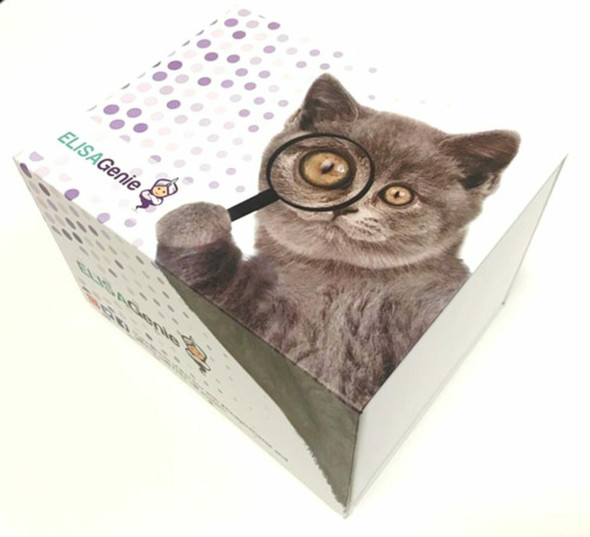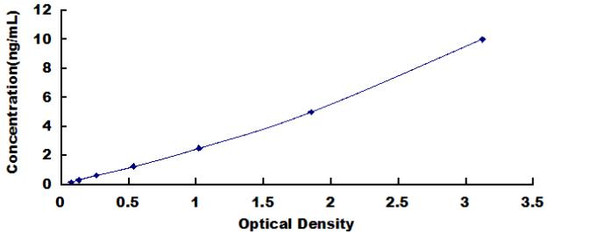Human GPER / G-protein coupled estrogen receptor 1 ELISA Kit
- SKU:
- HUFI01093
- Product Type:
- ELISA Kit
- Size:
- 96 Assays
- Uniprot:
- Q99527
- Sensitivity:
- 0.188ng/ml
- Range:
- 0.313-20ng/ml
- ELISA Type:
- Sandwich
- Synonyms:
- GPER, CEPR, CMKRL2, DRY12, FEG-1, GPCR-BR, GPR30, LERGU2, LERGU, LyGPR, FEG-1mER, G-protein coupled receptor 30, Chemoattractant receptor-like 2, chemokine receptor-like 2, constitutively expressed peptide-like receptor, IL8-related receptor DRY12, F
- Reactivity:
- Human
- Research Area:
- Cell Death
Description
Human GPER / G-protein coupled estrogen receptor 1 ELISA Kit
GPER is a member of the G-protein coupled receptor 1 family and encodes a multi-pass membrane protein that is found in the endoplasmic reticulum. GPER binds oestrogen and activates a number of downstream signalling pathways, including adenylate cyclase stimulation and an increase in cyclic AMP levels, as well as intracellular calcium mobilisation and phosphatidylinositol 3,4,5-triphosphate synthesis in the nucleus. As a result, GPER is involved in the rapid nongenomic signalling events that occur after oestrogen stimulation of cells and tissues. GPER has been linked to bone and nervous system development, metabolism, cognition, male fertility, and uterine function, among other biological processes. Estrogen-Receptor Negative Breast Cancer and Teeth Hard Tissue Disease are two diseases linked to GPER1.
| Product Name: | Human GPER / G-protein coupled estrogen receptor 1 ELISA Kit |
| Product Code: | HUFI01093 |
| Size: | 96 Assays |
| Alias: | GPER, CEPR, CMKRL2, DRY12, FEG-1, GPCR-BR, GPR30, LERGU2, LERGU, LyGPR, FEG-1mER, G-protein coupled receptor 30, Chemoattractant receptor-like 2, chemokine receptor-like 2, constitutively expressed peptide-like receptor, IL8-related receptor DRY12, Flow-induced endothelial G-protein coupled receptor 1, G-protein coupled estrogen receptor 1, heptahelix receptor, Lymphocyte-derived G-protein coupled receptor, Membrane estrogen receptor |
| Detection method: | Sandwich ELISA, Double Antibody |
| Application: | This immunoassay kit allows for the in vitro quantitative determination of Human GPER concentrations in serum plasma and other biological fluids. |
| Sensitivity: | 0.188ng/ml |
| Range: | 0.313-20ng/ml |
| Storage: | 4°C for 6 months |
| Note: | For Research Use Only |
| Recovery: | Matrices listed below were spiked with certain level of Human GPER and the recovery rates were calculated by comparing the measured value to the expected amount of Human GPER in samples. | ||||||||||||||||
| |||||||||||||||||
| Linearity: | The linearity of the kit was assayed by testing samples spiked with appropriate concentration of Human GPER and their serial dilutions. The results were demonstrated by the percentage of calculated concentration to the expected. | ||||||||||||||||
| |||||||||||||||||
| CV(%): | Intra-Assay: CV<8% Inter-Assay: CV<10% |
| Component | Quantity | Storage |
| ELISA Microplate (Dismountable) | 8×12 strips | 4°C for 6 months |
| Lyophilized Standard | 2 | 4°C/-20°C |
| Sample/Standard Dilution Buffer | 20ml | 4°C |
| Biotin-labeled Antibody(Concentrated) | 120ul | 4°C (Protect from light) |
| Antibody Dilution Buffer | 10ml | 4°C |
| HRP-Streptavidin Conjugate(SABC) | 120ul | 4°C (Protect from light) |
| SABC Dilution Buffer | 10ml | 4°C |
| TMB Substrate | 10ml | 4°C (Protect from light) |
| Stop Solution | 10ml | 4°C |
| Wash Buffer(25X) | 30ml | 4°C |
| Plate Sealer | 5 | - |
Other materials and equipment required:
- Microplate reader with 450 nm wavelength filter
- Multichannel Pipette, Pipette, microcentrifuge tubes and disposable pipette tips
- Incubator
- Deionized or distilled water
- Absorbent paper
- Buffer resevoir
| Uniprot | Q99527 |
| UniProt Protein Function: | GPER1: Receptor for estrogen. Belongs to the G-protein coupled receptor 1 family. |
| UniProt Protein Details: | Protein type:Membrane protein, integral; Motility/polarity/chemotaxis; Membrane protein, multi-pass; Receptor, GPCR; GPCR, family 1 Chromosomal Location of Human Ortholog: 7p22.3 Cellular Component: Golgi apparatus; integral to plasma membrane; early endosome; dendrite; nuclear envelope; trans-Golgi network; recycling endosome; perinuclear region of cytoplasm; cytoplasm; keratin filament; intracellular; dendritic shaft; endoplasmic reticulum membrane; cytoplasmic vesicle membrane; endoplasmic reticulum; postsynaptic density; Golgi membrane; presynaptic membrane; axon; mitochondrial membrane; presynaptic active zone; plasma membrane; nerve terminal; nucleus; cell junction Molecular Function:G-protein coupled receptor activity; protein binding; estrogen receptor activity; chromatin binding; mineralocorticoid receptor activity; steroid binding Biological Process: positive regulation of apoptosis; generation of action potential; positive regulation of caspase activity; nuclear fragmentation during apoptosis; negative regulation of DNA metabolic process; positive regulation of vasodilation; positive regulation of neurotransmitter secretion; negative regulation of leukocyte activation; negative regulation of cell proliferation; elevation of cytosolic calcium ion concentration; positive regulation of MAPKKK cascade; positive regulation of epidermal growth factor receptor signaling pathway; positive regulation of cAMP biosynthetic process; positive regulation of cell proliferation; inflammatory response; steroid hormone receptor signaling pathway; positive regulation of neurogenesis; cytosolic calcium ion homeostasis; negative regulation of lipid biosynthetic process; positive regulation of insulin secretion; positive regulation of inositol trisphosphate biosynthetic process; cell cycle; negative regulation of fat cell differentiation; apoptotic chromosome condensation; positive regulation of phosphoinositide 3-kinase cascade; G-protein coupled receptor protein signaling pathway; mineralocorticoid receptor signaling pathway; negative regulation of inflammatory response; positive regulation of G-protein coupled receptor protein signaling pathway; innate immune response; positive regulation of transcription from RNA polymerase II promoter; steroid hormone mediated signaling; positive regulation of protein amino acid phosphorylation; positive regulation of release of sequestered calcium ion into cytosol; positive regulation of cell migration |
| NCBI Summary: | This gene is a member of the G-protein coupled receptor 1 family and encodes a multi-pass membrane protein that localizes to the endoplasmic reticulum. The protein binds estrogen, resulting in intracellular calcium mobilization and synthesis of phosphatidylinositol 3,4,5-trisphosphate in the nucleus. This protein therefore plays a role in the rapid nongenomic signaling events widely observed following stimulation of cells and tissues with estrogen. Alternate transcriptional splice variants which encode the same protein have been characterized. [provided by RefSeq, Jul 2008] |
| UniProt Code: | Q99527 |
| NCBI GenInfo Identifier: | 3023539 |
| NCBI Gene ID: | 2852 |
| NCBI Accession: | Q99527.1 |
| UniProt Secondary Accession: | Q99527,Q8BMP4, O08878, |
| UniProt Related Accession: | Q99527 |
| Molecular Weight: | 42,248 Da |
| NCBI Full Name: | G-protein coupled estrogen receptor 1 |
| NCBI Synonym Full Names: | G protein-coupled estrogen receptor 1 |
| NCBI Official Symbol: | GPER1 |
| NCBI Official Synonym Symbols: | mER; CEPR; GPER; DRY12; FEG-1; GPR30; LERGU; LyGPR; CMKRL2; LERGU2; GPCR-Br |
| NCBI Protein Information: | G-protein coupled estrogen receptor 1; heptahelix receptor; chemokine receptor-like 2; IL8-related receptor DRY12; membrane estrogen receptor; G protein-coupled receptor 30; chemoattractant receptor-like 2; leucine rich protein in GPR30 3'UTR; lymphocyte- |
| UniProt Protein Name: | G-protein coupled estrogen receptor 1 |
| UniProt Synonym Protein Names: | Chemoattractant receptor-like 2; Flow-induced endothelial G-protein coupled receptor 1; FEG-1; G protein-coupled estrogen receptor 1; G-protein coupled receptor 30; GPCR-Br; IL8-related receptor DRY12; Lymphocyte-derived G-protein coupled receptor; LYGPR; Membrane estrogen receptor; mER |
| UniProt Gene Name: | GPER1 |
| UniProt Entry Name: | GPER1_HUMAN |
*Note: Protocols are specific to each batch/lot. For the correct instructions please follow the protocol included in your kit.
Before adding to wells, equilibrate the SABC working solution and TMB substrate for at least 30 min at 37°C. When diluting samples and reagents, they must be mixed completely and evenly. It is recommended to plot a standard curve for each test.
| Step | Protocol |
| 1. | Set standard, test sample and control (zero) wells on the pre-coated plate respectively, and then, record their positions. It is recommended to measure each standard and sample in duplicate. Wash plate 2 times before adding standard, sample and control (zero) wells! |
| 2. | Aliquot 0.1ml standard solutions into the standard wells. |
| 3. | Add 0.1 ml of Sample / Standard dilution buffer into the control (zero) well. |
| 4. | Add 0.1 ml of properly diluted sample ( Human serum, plasma, tissue homogenates and other biological fluids.) into test sample wells. |
| 5. | Seal the plate with a cover and incubate at 37 °C for 90 min. |
| 6. | Remove the cover and discard the plate content, clap the plate on the absorbent filter papers or other absorbent material. Do NOT let the wells completely dry at any time. Wash plate X2. |
| 7. | Add 0.1 ml of Biotin- detection antibody working solution into the above wells (standard, test sample & zero wells). Add the solution at the bottom of each well without touching the side wall. |
| 8. | Seal the plate with a cover and incubate at 37°C for 60 min. |
| 9. | Remove the cover, and wash plate 3 times with Wash buffer. Let wash buffer rest in wells for 1 min between each wash. |
| 10. | Add 0.1 ml of SABC working solution into each well, cover the plate and incubate at 37°C for 30 min. |
| 11. | Remove the cover and wash plate 5 times with Wash buffer, and each time let the wash buffer stay in the wells for 1-2 min. |
| 12. | Add 90 µl of TMB substrate into each well, cover the plate and incubate at 37°C in dark within 10-20 min. (Note: This incubation time is for reference use only, the optimal time should be determined by end user.) And the shades of blue can be seen in the first 3-4 wells (with most concentrated standard solutions), the other wells show no obvious color. |
| 13. | Add 50 µl of Stop solution into each well and mix thoroughly. The color changes into yellow immediately. |
| 14. | Read the O.D. absorbance at 450 nm in a microplate reader immediately after adding the stop solution. |
When carrying out an ELISA assay it is important to prepare your samples in order to achieve the best possible results. Below we have a list of procedures for the preparation of samples for different sample types.
| Sample Type | Protocol |
| Serum | If using serum separator tubes, allow samples to clot for 30 minutes at room temperature. Centrifuge for 10 minutes at 1,000x g. Collect the serum fraction and assay promptly or aliquot and store the samples at -80°C. Avoid multiple freeze-thaw cycles. If serum separator tubes are not being used, allow samples to clot overnight at 2-8°C. Centrifuge for 10 minutes at 1,000x g. Remove serum and assay promptly or aliquot and store the samples at -80°C. Avoid multiple freeze-thaw cycles. |
| Plasma | Collect plasma using EDTA or heparin as an anticoagulant. Centrifuge samples at 4°C for 15 mins at 1000 × g within 30 mins of collection. Collect the plasma fraction and assay promptly or aliquot and store the samples at -80°C. Avoid multiple freeze-thaw cycles. Note: Over haemolysed samples are not suitable for use with this kit. |
| Urine & Cerebrospinal Fluid | Collect the urine (mid-stream) in a sterile container, centrifuge for 20 mins at 2000-3000 rpm. Remove supernatant and assay immediately. If any precipitation is detected, repeat the centrifugation step. A similar protocol can be used for cerebrospinal fluid. |
| Cell culture supernatant | Collect the cell culture media by pipette, followed by centrifugation at 4°C for 20 mins at 1500 rpm. Collect the clear supernatant and assay immediately. |
| Cell lysates | Solubilize cells in lysis buffer and allow to sit on ice for 30 minutes. Centrifuge tubes at 14,000 x g for 5 minutes to remove insoluble material. Aliquot the supernatant into a new tube and discard the remaining whole cell extract. Quantify total protein concentration using a total protein assay. Assay immediately or aliquot and store at ≤ -20 °C. |
| Tissue homogenates | The preparation of tissue homogenates will vary depending upon tissue type. Rinse tissue with 1X PBS to remove excess blood & homogenize in 20ml of 1X PBS (including protease inhibitors) and store overnight at ≤ -20°C. Two freeze-thaw cycles are required to break the cell membranes. To further disrupt the cell membranes you can sonicate the samples. Centrifuge homogenates for 5 mins at 5000xg. Remove the supernatant and assay immediately or aliquot and store at -20°C or -80°C. |
| Tissue lysates | Rinse tissue with PBS, cut into 1-2 mm pieces, and homogenize with a tissue homogenizer in PBS. Add an equal volume of RIPA buffer containing protease inhibitors and lyse tissues at room temperature for 30 minutes with gentle agitation. Centrifuge to remove debris. Quantify total protein concentration using a total protein assay. Assay immediately or aliquot and store at ≤ -20 °C. |
| Breast Milk | Collect milk samples and centrifuge at 10,000 x g for 60 min at 4°C. Aliquot the supernatant and assay. For long term use, store samples at -80°C. Minimize freeze/thaw cycles. |
Fill out our quote form below and a dedicated member of staff will get back to you within one working day!






